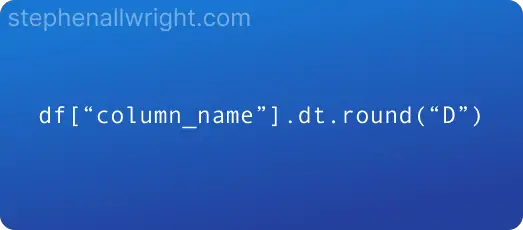
Pandas round DateTime to day
Being able to round a DateTime object in Python to the nearest day can be extremely helpful for feature engineering. In this post, I will walk through how to do this simply in multiple variations.
Being able to round a DateTime object in Python to the nearest day can be extremely helpful for feature engineering. In this post, I will walk through how to do this simply in multiple variations.
How does Pandas round to the nearest day?
In order to round a DateTime object to the nearest day, you need to use the round operation from Pandas on the DateTime column and specify the frequency that you want to use. For rounding to the nearest day you will need to use round("D").

Pandas round DateTime to day
Below is a simple example of how you can round to the nearest day and return this as a DateTime object.
import pandas as pd
df = pd.DataFrame(
columns=["datetime"],
data=pd.date_range("1/1/2022 09:00:00", periods=6, freq="H"))
df["day_datetime"] = df["datetime"].dt.round("D")
"""
Output:
datetime day_datetime
0 2022-01-01 09:00:00 2022-01-01
1 2022-01-01 10:00:00 2022-01-01
2 2022-01-01 11:00:00 2022-01-01
3 2022-01-01 12:00:00 2022-01-02
4 2022-01-01 13:00:00 2022-01-02
5 2022-01-01 14:00:00 2022-01-02
"""
Pandas round DateTime to day and return as integer
You may also want to return the day as an integer instead of a DateTime object, this is possible with just a small addition to the previous example.
import pandas as pd
df = pd.DataFrame(
columns=["datetime"],
data=pd.date_range("1/1/2022 09:00:00", periods=6, freq="H"))
df["day_integer"] = df["datetime"].dt.round("D").dt.day
"""
Output:
datetime day_integer
0 2022-01-01 09:00:00 1
1 2022-01-01 10:00:00 1
2 2022-01-01 11:00:00 1
3 2022-01-01 12:00:00 2
4 2022-01-01 13:00:00 2
5 2022-01-01 14:00:00 2
"""
Round Pandas DateTime down to nearest day
The round operation from Pandas rounds to the nearest day, but what if you want to always round down to the nearest day? Well, for this you need to use the floor operation.
import pandas as pd
df = pd.DataFrame(
columns=["datetime"],
data=pd.date_range("1/1/2022 09:00:00", periods=6, freq="H"))
df["round_down_day_datetime"] = df["datetime"].dt.floor("D")
df["round_down_day_integer"] = df["datetime"].dt.floor("D").dt.day
"""
Output:
datetime round_down_day_datetime round_down_day_integer
0 2022-01-01 09:00:00 2022-01-01 1
1 2022-01-01 10:00:00 2022-01-01 1
2 2022-01-01 11:00:00 2022-01-01 1
3 2022-01-01 12:00:00 2022-01-01 1
4 2022-01-01 13:00:00 2022-01-01 1
5 2022-01-01 14:00:00 2022-01-01 1
"""
Round Pandas DateTime up to nearest day
Likewise, if you want to always round up the nearest day you need to use the ceil operation.
import pandas as pd
df = pd.DataFrame(
columns=["datetime"],
data=pd.date_range("1/1/2022 09:00:00", periods=6, freq="H"))
df["round_up_day_datetime"] = df["datetime"].dt.ceil("D")
df["round_up_day_integer"] = df["datetime"].dt.ceil("D").dt.day
"""
Output:
datetime round_up_day_datetime round_up_day_integer
0 2022-01-01 09:00:00 2022-01-02 2
1 2022-01-01 10:00:00 2022-01-02 2
2 2022-01-01 11:00:00 2022-01-02 2
3 2022-01-01 12:00:00 2022-01-02 2
4 2022-01-01 13:00:00 2022-01-02 2
5 2022-01-01 14:00:00 2022-01-02 2
"""
Related articles
Round Pandas DateTime to nearest week
Round Pandas DateTime to start or end of month
Round Python DateTime to week number
Round Python DateTime to month number
Convert Pandas DateTime to date
Round Python DateTime to year
Round Pandas DateTime to year
References
Pandas round documentation
Pandas floor documentation
Pandas ceil documentation
